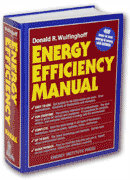Overview of…
9.3 Lamps and Fixtures, High Intensity Discharge
This part of the Energy Efficiency Manual shows how to lower the cost of lighting by the efficient use of high intensity discharge lighting, commonly called HID lighting. It covers HID lamps, ballasts, and lighting fixtures (also called “luminaires”). In addition, it covers low-pressure sodium lighting, which is a similar technology, but is limited to specialized applications.
High-intensity discharge (“HID”) lighting has long been the dominant type for industrial facilities and outdoor lighting. Major improvements in color rendering have allowed HID lighting to move into the commercial sector, where it competes with incandescent and fluorescent lighting for many applications.
The first type of HID lighting was mercury vapor. In recent decades, mercury vapor lighting was joined by metal halide and high-pressure sodium lighting. The two newer types offer much better color rendering and higher efficiency, leaving lower cost as the only remaining advantage of mercury vapor.
Low-pressure sodium lighting does not fit within the strict definition of HID lighting, but it is similar in operation and installation. It has exceptionally high electrical efficiency. Unfortunately, it is limited in application by its poor color rendering.
Here you will learn to optimize fluorescent lighting design in new applications and to improve or retrofit HID lighting in existing facilities. Explained here are the selection factors for HID lamps, including light output, lumen depreciation, wattage, efficiency (called “luminous efficacy” by specialists), lamp color, color rendering, service life, operating temperatures, mounting position limitations, cost, and other factors.
Also explained are the selection factors for HID ballasts, which must be matched precisely to the lamps. At present, most HID ballasts are magnetic. The main types are reactor ballasts, constant wattage ballasts, and constant wattage autotransformer ballasts. Their characteristics include input wattage, current output, crest factor, efficiency, lamp compatibility, starting temperature, dimming capability, acoustical noise, power factor, and harmonic distortion. Ballasts for metal halide lamps and high pressure sodium lamps may require separate capacitors or ignitors.
Dimming of HID lamps is still limited. Here you will learn to deal with the limitations of dimming, including color changes, starting difficulty, and mounting position limitations.
At present, there are fewer opportunities for improving HID lighting than for fluorescent and incandescent lighting. Unlike the other two types, HID lighting forces you to compromise between efficiency and color rendering. HID provides fewer ways to make small reductions in wattage. Delamping opportunities are more limited because of their large wattage and focussed light distribution. Opportunities for improving control are limited by long starting and restarting times.
HID lamps with much better efficiency have become available in recent years, but the efficiency of common HID ballasts continues to be poor. Electronic ballasts may create the same opportunities for conservation in HID lighting that they did in fluorescent lighting, and they may lessen or overcome the starting and restarting problems of HID.
Click here to return to the Table of Contents


